Reviewed by Steffen Brown
In his ode, To Helena, the poet Horace writes “that when Prometheus was assigned/ the task of making each of us what we are,/ he put into each one of us something of/ each other creature that there is in nature.” Martin Corless-Smith, in his latest book, Swallows, constructs verse in a manner similar to Horaces’ Prometheus divining characteristics to man; the poems rise up from an historical patchwork of literary personae (Donne, Sir Thomas Brown, William Williamson, Sebald), establishing an individualized architecture of poetry that constantly pecks at the metaphysics and creation of poetry. At one point, Corless-Smith writes:
You might ask if human art (ars) is merely the monstrous—then/ why do I continue? Because I must confirm, and continue the monstrous. And/ I want to make it. Believing it to be nothing more than its own self—its own/ modest enterprise which may be the last growth on this branch or may prove/ a limb or a trunk.
For someone wanting to confirm the “monstrous,” Corless-Smith proceeds in an entirely anti-Frankensteinian manner, constructing a verse that, for the most part, is supple and resistant to the destruction of the world his words create. Without relying on gimmick or shtick, Corless-Smith manages to produce poetry that is singular and uniquely new, while at the same time respectfully entrenching his work in the complexity and conventions of many of the romantic poets. Yet, the poems in Swallows are anything but conventional. Throughout, the verse slips seamlessly from lyric to pastoral, refusing to concretize a boundary for the world in which they operate. The poems adopt different voices, some seemingly imagined and some historical, which produce a dreamlike poetic of impermanence and importance.
As a whole, Swallows is a portrait of place, self, and poetry, and it articulates these things in Donnian complexity and conceit. The work is at its best when place and self are most prevalent, as in “FROM PAPYRI,” where Corless-Smith writes, “Now I would go forth into the fields to listen to my own foolish heart/ Far from home my life was settled. Yet I turned and return as I must/ These things are done in secret: whom do you fear?” The stern consternation of such lines is redolent of Corless-Smith’s notion of “the act of poetry…” as “…the acknowledgement of separation.” Throughout the book, the acknowledgement of separation persists between audience and performer, points in time, and especially between self and place.
In the poem “IMITATIONS OF HORACE (KEATS),” Corless-Smith writes that, “the poem is just a patch/ of sunlight moving over grass/ over a breathing field.” The poems in Swallows seem to be born from such ephemerality. They are mysterious and diffuse. Like Horace’s Sabine Villa, these poems resist attachment to an actual place in the world, and instead they hover above the crossroads of history and imagination. In the beginning of the book, Corless-Smith writes that, “my idea—Poetry—kissed the hand/ for so long—waiting for someone to do/ something.” That “something” is what we get in Swallows: a complex and persuasive work that feels reminiscent of an older poetry, yet its trajectory is original, new, and perhaps, unlike anything being written today.
**
MARTIN CORLESS-SMITH is the author of Nota (Fence Books), Complete Travels (West House Books), and Of Piscator (University of Georgia Press). He is a native of Worcestershire, England, to which he returns each summer, though he currently lives and teaches in Boise, Idaho
**
STEFFEN BROWN lives and works in Missoula, Montana, where he preserves and re-binds old books for the University of Montana. In the Fall, he will be a student in the MFA program at Boise State University.



